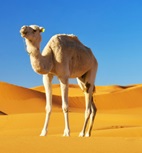What is Adaptations in Animals?
1) How Do Animals Survive Without Eating and Drinking During Hibernation?
- Animals feed on a considerable amount of food before going for long winter sleep. It helps them develop good fat reserves in the body, which are used as a source of energy during hibernation.
- Also, the rate of metabolic activities of animals during hibernation is very low.
- The rate of heartbeat and breathing are lower than usual, which helps them conserve more energy.
- There is a fall in the body temperature which reduces the consumption of water too.

2) What Is Acclimatization? Do We Need To Acclimatize? If Yes, Give an Example.
- Acclimatization indicates the changes that occur in the body of an organism to get accustomed to the changes in climate.
- Yes, we need to acclimate when we travel to places with a very different climate from the places we live in.
- For example, while travelling to places at high altitudes, our body takes some time to get used to thin air and low oxygen levels. We tend to fall ill due to the low oxygen available in the air but get acclimatized to it after a few days. It happens because our body increases the number of red blood cells so that they can absorb more oxygen.
3) How Can a Chameleon Change Its Skin Colour?
- A chameleon has specialised cells called chromatophores in its body.
- These chromatophores are filled with pigments of different colours.
- The type of colour the skin of a chameleon reflects at a time depends on the nerve impulse and secretion of hormones initiated due to the external stimulus.

4) Why Do Penguins Huddle on Extreme Cold, Windy Days?
- The feathers on the body of a penguin are not enough to fight the extreme cold.
- They huddle so that they can share the heat from the body of other penguins.
- They keep changing their positions while huddling from the outer to the inner side so that all the members can survive the extreme cold conditions.

5) The Skin of Elephants Has Many Wrinkles. Why?
- The skin of elephants has many wrinkles. It is an adaptation for survival in the hot climate.
- The wrinkled skin traps water that takes a longer time to evaporate and keeps an elephant’s body cool.

6) A Camel Has Long Legs. Do You Think It Is an Adaptation To Survive in Hot Climatic Conditions? If Yes, Give Reasons for the Same.
Yes, the long legs of camel are an adaptation to survive in the hot climatic conditions of a desert.
The sand in the desert heats up very quickly and may reach an unbearable temperature. Due to its long legs, the body of a camel remains at a considerable distance from the sand.

7) How Does a Streamlined Body Make Some Animals Better Swimmers?
- While swimming, the body experiences a resistant force due to friction between water and the body’s surface.
- Such fluid friction is also called drag.
- The streamlined body helps in decreasing the drag and hence, helps to swim more efficiently.
8) Why Is Sultanpur in Haryana Famous?
- Sultanpur in Haryana is famous for a variety of bird species.
- It is renowned for both migratory and resident bird species.
- The resident bird species include the common spoonbill, Indian roller, black francolin, back-necked stork, etc.
- The migratory bird species include Siberian crane, greater flamingo, yellow wagtail, and spot billed pelican.
CBSE Schools In Popular Cities
- CBSE Schools in Bangalore
- CBSE Schools in Mumbai
- CBSE Schools in Pune
- CBSE Schools in Hyderabad
- CBSE Schools in Chennai
- CBSE Schools in Gurgaon
- CBSE Schools in Kolkata
- CBSE Schools in Indore
- CBSE Schools in Sonipat
- CBSE Schools in Delhi
- CBSE Schools in Rohtak
- CBSE Schools in Bhopal
- CBSE Schools in Aurangabad
- CBSE Schools in Jabalpur
- CBSE Schools in Jaipur
- CBSE Schools in Jodhpur
- CBSE Schools in Nagpur
- CBSE Schools in Ahmednagar
- CBSE School In Tumkur











